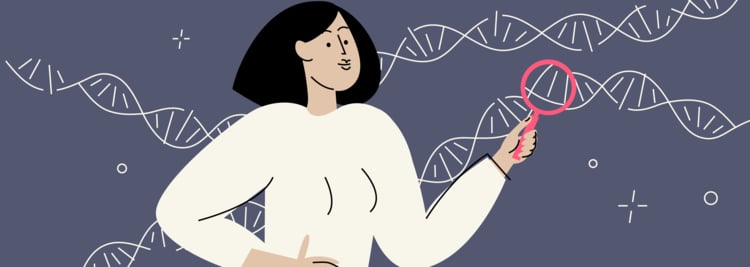Every parent wonders about their baby’s appearance before the child is born. But the answer to the question “What will my baby look like?” isn't a mystery anymore, thanks to advancements in the studies of genetic traits. The study of genetic inheritance is a solid science now, and genetic traits can be predicted to some extent. If you’re wondering which inherited traits your baby will show, science can offer some predictions.
-
Tracking cycle
-
Getting pregnant
-
Pregnancy
-
Help Center
-
Flo for Partners
-
Anonymous Mode
-
Flo app reviews
-
Flo Premium New
-
Secret Chats New
-
Symptom Checker New
-
Your cycle
-
Health 360°
-
Getting pregnant
-
Pregnancy
-
Being a mom
-
LGBTQ+
-
Quizzes
-
Ovulation calculator
-
hCG calculator
-
Pregnancy test calculator
-
Menstrual cycle calculator
-
Period calculator
-
Implantation calculator
-
Pregnancy weeks to months calculator
-
Pregnancy due date calculator
-
IVF and FET due date calculator
-
Due date calculator by ultrasound
-
Medical Affairs
-
Science & Research
-
Pass It On Project New
-
Privacy Portal
-
Press Center
-
Flo Accuracy
-
Careers
-
Contact Us
Genetic Inheritance: What Will Your Baby Look Like?


Every piece of content at Flo Health adheres to the highest editorial standards for language, style, and medical accuracy. To learn what we do to deliver the best health and lifestyle insights to you, check out our content review principles.
How genetic inheritance works
Part of the study of genetics includes the combination of genes that parents pass on to their children. If you’re wondering what your baby will look like, genetics holds the answer to your question and many others. Genetics will largely determine the physical characteristics of your baby and even some of the talents and personality traits your child will have.
An important part of the study of genetics can be traced back to a scientist named Gregor Mendel. He studied pea plants in the 19th century and carefully observed genetic changes in the plants from generation to generation. He found that genetic traits can be transmitted and passed down. Phenotypes, or physical characteristics, come from genes that can either be dominant or recessive.
Dominant traits can be seen in multiple generations, while recessive traits won’t be seen in every generation. As its name suggests, if a dominant trait pairs up with a recessive trait, the dominant trait will be expressed, and the recessive one will remain hidden. For example, if you have a dominant gene for a large nose and your partner has a recessive gene for a small nose, there’s a greater chance of your child having a large nose. Even simple physical characteristics, like the size of your nose, are made up of many different genes and their expression, though, so it’s rarely that simple or straightforward.
How sex is determined
Take a quiz
Find out what you can do with our Health Assistant

The human genome is made up of 23 pairs of chromosomes. One of these pairs are known as sex chromosomes and are characterized as being either XY or XX. Females almost always have two X chromosomes (XX), and males almost always have an X and a Y chromosome (XY). Because each parent contributes one side of the pair, females can only contribute one of their X chromosomes, while males can contribute either an X or a Y. If both parents contribute an X chromosome, the 23rd chromosome will be XX, and the child will be a female. An XY chromosome means the child will be a male.
The X chromosome contains about 800 to 900 genes, while the Y chromosome has only 50 to 60. Each gene has a strand from each parent, forming the double-helix pattern of DNA. The Y chromosome genes are mainly responsible for male sex characteristics. It contains the SRY gene, which leads to the development of male phenotypes like the testes.
Humans have always been interested in ways to determine a baby’s sex before it’s born. Many of the prediction theories have been around for centuries, but now you can find out definitively with an ultrasound. You can’t be completely sure which inherited traits your baby will show, but general information on genetic inheritance and genetic traits can give you a rough idea.
While you wait to see your baby for the first time, you might like to know how it’s expected to develop in the womb. A pregnancy tracking app like Flo can give you day-by-day updates and even share them with your partner using Flo for Partners.
What will your baby look like?
Parents often wonder what their baby will look like. Here are some of the main characteristics people often wonder about.
Eyes
Eye color is determined by the amount of melanin in the eyes. Chromosome 15 contains the genes that are directly involved in determining eye color, OCA2 and HERC2. The OCA2 gene produces a P protein, which helps develop the structures that produce melanin. These structures are called melanosomes. If there is less P protein, fewer melanosomes will be produced, and there will be less melanin in the eyes, resulting in lighter eyes.
If both parents carry a recessive or hidden gene for lighter eyes, the child has a 25 percent chance of being born with light eyes.
Eyes with more melanin are dominant, which is why more people in the world have dark eyes. However, if both parents carry a recessive or hidden gene for lighter eyes (even if the parents themselves both have dark eyes), the child has a 25 percent chance of being born with light eyes. Eye color can also change as a baby grows and melanin production changes.
Hair
Determining hair color is less straightforward than figuring out the eye color of a baby. One important gene, called MC1R, helps make a protein that’s also involved in melanin production. Each parent donates one copy of the gene, and if both are functioning properly, then the child will have brown or black hair.
The forms of melanin found in hair are called eumelanin and pheomelanin. If one copy of the MC1R gene is deactivated and doesn’t function, the baby will produce less eumelanin but more pheomelanin, giving them red, auburn, or brown-blonde hair. If both copies of the gene are deactivated, then the child will have blonde or bright-red hair. The best way to determine hair color is to look at your own family tree.
Skin
If you ignore sun exposure, most forms of skin color are inherited from a child’s parents. There are multiple genes that determine skin color, meaning it’s determined by something called polygenic inheritance. Genetics are influenced by location, however, as historians and scientists have discovered.
People from equatorial areas have more melanin because it protects them from harmful UV rays. People from far northern areas like Northern Europe have less melanin because their body needs to absorb as much vitamin D as possible. As an example, if you have ancestors from Africa or southern Asia, you can expect your baby to have more melanin than someone with strictly European ancestry.
Body
Body type is also determined largely by genetics. One large study conducted with Dutch twin children found that there was strong evidence of genetic heritability in body mass and moderate heritability in height. Environment and lifestyle have a large influence over body type, however — more so than many other traits. Someone with darker hair can move to an area with more sunlight and their hair may lighten, but the change is more drastic for individuals who work to change their body type.
One large study conducted with Dutch twin children found that there was strong evidence of genetic heritability in body mass and moderate heritability in height.
If you have a genetic predisposition for weight gain or obesity, a sedentary lifestyle will compound the effects of your genetics. An active lifestyle, on the other hand, will work to silence certain genes. The field of epigenetics focuses on this and has found that a person’s environment can cause certain genes to shut off or never be expressed at all. If your child has a predisposition for obesity, for example, a healthy lifestyle and activity level can mean this gene will never be expressed as they grow up.
Can character be inherited?
Character and personality traits can be inherited much like physical characteristics. Scientists believe that 20 to 60 percent of temperament is determined by genetics. For example, studies done on twins raised in separate environments show that they still share many characteristics and personality traits, suggesting a genetic influence.
Some genes have a direct influence on personality, and these can be inherited from a child’s parents. For example, variations in the DRD2 and DRD4 genes are related to curiosity. Other genes, like KATNAL2, can translate to carefulness and diligence. Despite this, scientists stress that it’s not clear if and how temperament is inherited, and there are many gene variations that contribute to which inherited traits are observable.
Epigenetics also plays a role in inherited traits. The traits of a parent might not be expressed if the child isn’t exposed to the environment that caused the traits in the parent. Plus, personality traits that are acquired throughout a parent’s life may change how their own genes act but won’t affect their child’s genes.
What if your child doesn’t look like you?
It’s possible for your child to have characteristics that aren’t recognizable in you or your partner. Since many inherited traits are determined by multiple genes, there may be other influences in your baby’s appearance that weren’t present in yours.
Recessive and dominant traits have a lot of influence over your baby’s appearance. If both you and your partner have light skin, but you have family members with dark skin, you carry the recessive trait for dark skin and may see it in your child. Scientists call the wiggle room in the expression of certain genes “genetic variations.” It’s uncommon, but parents can have children with traits different from their own, such as a child with brown eyes when the parents are both blue-eyed. Genetic testing can be a great way to learn more about you and your child’s ancestry.
Bottom line
The bottom line is that there’s no specific way to determine your child’s appearance, personality, or traits. It’s not, however, entirely a game of chance. Some genetics are passed down and can’t be changed, while the expression of others can be influenced by other factors. Eye, hair, and skin color are fairly stable and predictable, while body type and personality can be swayed by other factors.
Genetic inheritance isn’t a game of chance. It can be an interesting topic to learn more about before your baby is born to form a mental picture of your little one. By learning about genetic traits, you’ll know your baby even before you hold them in your arms for the first time.


Hey, I'm Anique
I started using Flo app to track my period and ovulation because we wanted to have a baby.


The Flo app helped me learn about my body and spot ovulation signs during our conception journey.


I vividly
remember the day
that we switched
Flo into
Pregnancy Mode — it was
such a special
moment.
Real stories, real results
Learn how the Flo app became an amazing cheerleader for us on our conception journey.




